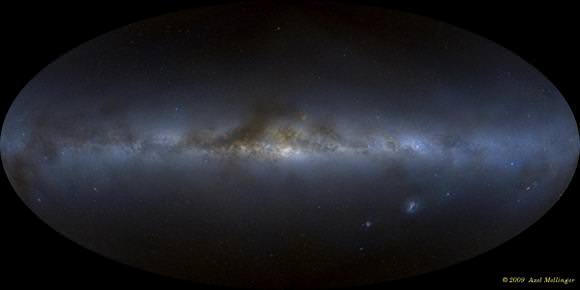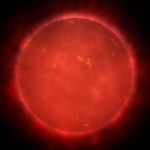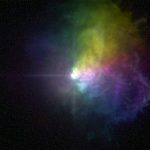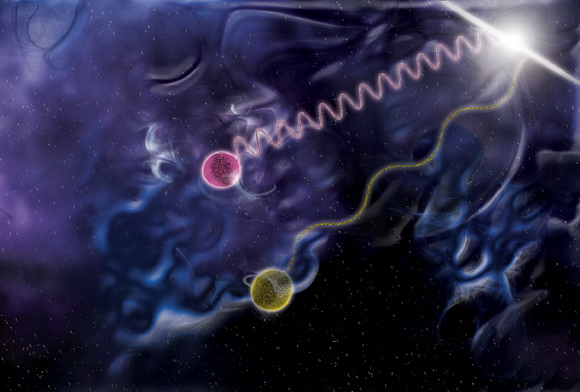1 Milky Way; 3,000 Images

What a gorgeous and immense image! And it's full of stars! An astronomer from Central Michigan University has put together a new high-resolution panoramic image of the full night sky , with the Milky Way galaxy as its centerpiece. Axel Mellinger stitched together over 3,000 images to create this beautiful image, which also comes in an interactive version, showing stars 1,000 times fainter than the human eye can see, as well as hundreds of galaxies, star clusters and nebulae.
(...)
Read the rest of 1 Milky Way; 3,000 Images (254 words)
NASA Science News for October 30, 2009
NASA's next Mars rover, a super-capable robot named "Curiosity," will push Mars exploration to a new level.
FULL STORY at
http://science.nasa.gov/headlines/y2009/30oct_curiosity.htm?list1035898
Volunteers Still Needed for Simulated Mars Mission

Need to get away from it all? If you have a background in medicine, computers or engineering and can speak a little Russian and English, this might be just what you are looking for. The European Space Agency and the Russian Institute of Medical and Biological Problems are still looking for volunteers to participate in a 520-day simulation of an expedition to Mars. The institute announced last week the opening of registration, but haven't yet gotten enough applicants. The nearly two-year experiment will simulate all aspects of a journey to the Red Planet, with a 250-day outward trip, a 30-day stay on its surface, and a 240-day return flight.
(...)
Read the rest of Volunteers Still Needed for Simulated Mars Mission (282 words)
Einstein Still Rules, Says Fermi Telescope Team
While the Fermi Space Telescope has mapped the gamma ray sky with unprecedented resolution and sensitivity, it now has been able to take a measurement that has provided rare experimental evidence about the very structure of space and time, unified as space-time. Einstein's theory of relativity states that all electromagnetic radiation travels through a vacuum at the same speed. Fermi detected two gamma ray photons which varied widely in energy; yet even after traveling 7 billion years, the two different photons arrived almost simultaneously.
(...)
Read the rest of Einstein Still Rules, Says Fermi Telescope Team (378 words)
Supernova 2009js… Another One Bites The Dust!
Far away in the constellation of Aries, in a 14th magnitude barred spiral galaxy designated as NGC 918… a star exploded with enough candlepower to briefly outshine its home. Discovered independently by Lick Observatory Supernova Search (LOSS) and Koichi Itagaki (Japan) on October 11, 2009, this Type II supernova might be hiding in the intergalactic dust, but it isn't hiding from Joe Brimacombe. (...)
Read the rest of Supernova 2009js… Another One Bites The Dust! (610 words)
Free NASA iPhone App
NASA announced last week they had developed the first iPhone application geared specifically for keeping track of all things NASA. I don't have an iPhone, so I didn't look into it, but the iPhone users I know seem to be very excited about it. So here's all the info you should need to hook up with NASA via your iPhone:
The NASA App is available free of charge on the App Store from Apple directly to the iPhone and iPod Touch or within iTunes.
What does it do?
(...)
Read the rest of Free NASA iPhone App (146 words)
Exploring With an Armada of Autonomous Robots
JPL has a fun article on their website detailing what future robotic exploration might entail: an armada of robots could one day fly above the mountain tops of Saturn's moon Titan, cross its vast dunes and sail in its liquid lakes. This is the vision of Wolfgang Fink, from the California Institute of Technology. He says we are on the brink of a great paradigm shift in planetary exploration, and the next round of robotic explorers will be nothing like what we see today.
(...)
Read the rest of Exploring With an Armada of Autonomous Robots (592 words)
Impact in Latvia Creates 20-Meter Crater

A possible meteorite fall near in northern Latvia on Sunday left a crater approximately 20 meters (66 feet) in diameter and 10 meters (33 feet) deep. UPDATE: Many reports now say the impact was a fake; The Bad Astronomer says "shovel" marks were found around the perimeter of the crater; additionally, a burning impactor is highly unlikely (see video below). And here's an article from the Associated press. , and another from Yahoo news, where a phone company in Latvia admits the "crater" was a publicity stunt.
(...)
Read the rest of Impact in Latvia Creates 20-Meter Crater (167 words)
NASA Science News for October 27, 2009
It might not be obvious to the naked eye, but the sun is a variable star. A sensor slated for launch onboard NASA's Solar Dynamics Observatory will probe the sun's "sneaky variability" with better time and spectral resolution than ever before.
FULL STORY at
http://science.nasa.gov/headlines/y2009/27oct_eve.htm?list1035898
Podcast: Dwarf Stars

We think we live near an average star, but that's not the case at all. Compared to most stars in the Universe, the Sun is a giant! Let's look at the small end of the stellar spectrum, to stars with a fraction of the size and mass of our own Sun. There are many ways that a star can get small, and they lead dramatically different lives and deaths.
Click here to download the episode.
Or subscribe to: astronomycast.com/podcast.xml with your podcatching software.
Podcast: Famous Stars

This week we're going to talk about famous stars. But not those boring human ones you read about in People magazine. No, we're talking about those hot balls of plasma across the distant Universe. The close ones, the bright ones, the massive ones, the giant ones. Let's get to know some famous stars.
Click here to download the episode.
Or subscribe to: astronomycast.com/podcast.xml with your podcatching software.
Top Questions That Keep Physicists Awake at Night

We all have things that keep us up at night, as we try to solve the problems in our lives. But just think of the poor physicists: They are trying to solve the problems of the Universe! At a recent physics conference at the Perimeter Institute for Theoretical Physics in Waterloo, Canada, a panel of scientists were asked what questions in physics kept them awake at night. Here are their answers:
(...)
Read the rest of Top Questions That Keep Physicists Awake at Night (136 words)
NASA Science News for October 23, 2009
NASA is planning a mission to study the Moon's fragile atmosphere--before it's too late.
FULL STORY at
http://science.nasa.gov/headlines/y2009/23oct_ladee.htm?list1035898
Missions to Mars Poster

If you enjoyed the zoomable poster of 50 year of space exploration, you'll probably also like this new poster of Mars missions. It's basically a bar graph, with missions to Mars as listed chronologically, and the mission result is coded by how close the corresponding bar reaches to Mars. The poster also lists a few of the upcoming missions as well. Cool!
Committee Urges Multi-Destination Plan for NASA Human Space Flig

The Augustine Commission released their final report today, and while they didn't offer specific recommendations for NASA's human space flight program, they laid out five possible options, highlighting a flexible plan that allows for several destinations out of low Earth orbit. The report also encouraged commercial space ventures to handle trips to the International Space Station. "The different options speak for themselves," said head of the commission, Norman Augustine at a press briefing today following the release of the report. "We believe Mars is clear goal of the human spaceflight program, but for safety reason we ruled out going directly there. We've offered programs that are alternatives for building a heavy lift launch capability, as we believe that to be extremely important for the human space program, and we believe this is the time to create a commercial market to transport humans to Earth orbit."
But the strongest point the committee made is that NASA needs additional funds of $3 billion a year in order to accomplish much of anything.
(...)
Read the rest of Committee Urges Multi-Destination Plan for NASA Human Space Flight (1,058 words)



